Pictures: www.clickatlife.gr
Right in the middle of the Aegean Sea (http://bit.ly/14KUVh2), Paros seems to dominate the Cycladic islands, with rare island beauty, endless beaches and numerous attractions and opportunities for recreation and entertainment for all tastes. Calm, traditional and picturesque, it manages to combine worlds and cultures like no other island. Paros is the third largest Cycladic Island, located to the west of Naxos, representing a crossroads of maritime routes that link mainland Greece with the Aegean islands, Asia Minor and the Mediterranean coast.
The shores of the island, which form beautiful beaches and natural coves mainly in the eastern part, and which in other places are steep and rocky, are scattered in the north. A large bay is formed there - Naoussa, one of the most picturesque Aegean ports. Another two large bays are located to the west - Parikia, and Marmara to the east.
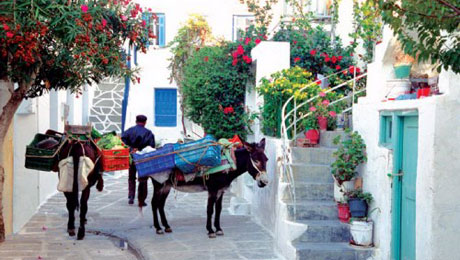
Parikia, built right in the middle of the west coast around a large bay is the capital of the island, an administrative and economic centre and major port. Walking in the city and along the narrow streets around Castro (the old market), and the coastal road, you will find taverns and restaurants that offer delicious dishes from local, Greek and international cuisine. And when the sun sets, the nightlife begins in the dozens of bars, cafes and clubs.
Once a centre of notorious pirates, Naoussa is located in a protected bay on the north coast, and is undoubtedly one of the most picturesque harbours in the Aegean Sea, with many tourists, dozens of hotels and rooms to rent, camping, travel agencies, rent-a-car, restaurants, cafes, markets and lively nightlife. In parallel, it has preserved its significance as a traditional fishing village with the largest fishing fleet of the Cycladic islands. Today, the old warehouses of fishermen have become restaurants serving fresh seafood appetizers. Naoussa’s residents love entertainment, dancing and singing. Every summer, on the first Sunday of July, wine and fish celebrations take place there. Another big celebration takes place on the night of corsairs on 23 August.
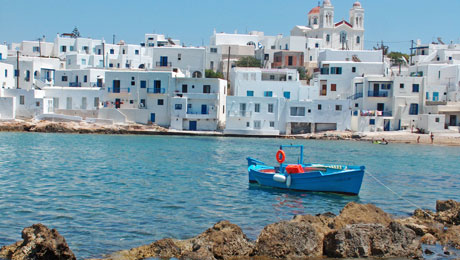
Marpisa is located in the eastern part of Paros. It is built amphitheatrically on a hill near the sea. This is a very beautiful village famous for its Easter celebrations, with a mild climate, interesting architecture, picturesque windmills, beautiful houses and churches from the 16th century. The Ethnographic Museum is located on St. Nicholas Square and there are many monasteries near the village.
From Marpisa, you can go to Piso Livadi, a beautiful fishing village with a lot of tourists and beaches.
Near Marpisa, you will also find the village of Marmara, named after its marble, which was used to decorate manor houses and churches. The village’s gem is the church of Panagia Marmarini from the 17th century, which celebrates on 8 September. Visitors can also see here marble tubs where women of the village used to wash.
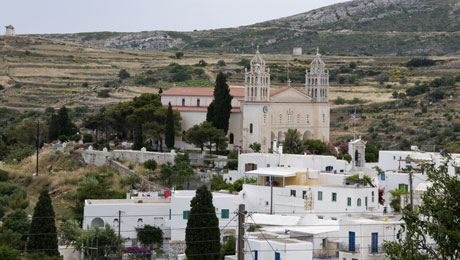
Moving further to the interior of the island, you will find Lefkes (11 km from Parikia), a beautiful green mountain village, built amphitheatrically at an altitude of 250 m. In Lefkes, cars are parked in a parking lot at the entrance, since the village is a pedestrian zone.
In the south of Paros, you will find Aliki, a quiet fishing village that attracts those seeking tranquillity. Here are the best beaches on the island, protected from the Meltemi winds of the Aegean Sea.
The Virgin Mary of Paros
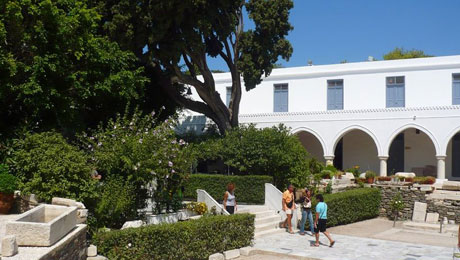
The holy gem of the island is Panagia Ekantontapiliani (Our Lady of the Hundred Gates), one of the most important Byzantine monuments of Greece built in the 4th century. It was partially destroyed, probably because of a fire, and was rebuilt by Emperor Justinian in the 6th century. It is located near the main port of the city. This is the largest pilgrimage site after Mount Athos. The holy icon of the Virgin is from the 17th century. The church has a Byzantine museum with rare icons from the Byzantine and Ottoman period. The biggest celebration of the island takes place on 15 August, on Assumption day.
Beaches
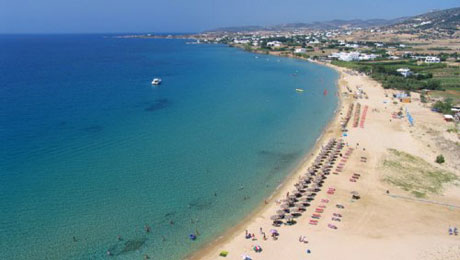
Paros boasts endless beaches, with and without tourist facilities, with pebbles or sand – for all tastes. You can visit Chryssi Akti in the south-eastern part of the island, and Langeri in the northeast, near Naoussa, Faranga beach near Aliki, and Martselo beach near Parikia.
Other famous beaches are Kolymbithres, Molos, Krios, Parasporos and many more. Additional information about the beaches of Paros can be found on: www.paros.gr/default.asp?catid=4374.
Parian Marble
The ancient quarries of Paros are located about 5 km from Parikia. They are known for their exceptional white marble which is mined there. This marble was used to build famous statues such as the Venus de Milo, Hermes of Praxiteles and Nike of Samothrace. Remains of buildings are preserved in the area, too.

Where to eat (recommended by locals):
- Budaraki for tasty home-made dishes; Corali and Apostolis for fish in Parikia